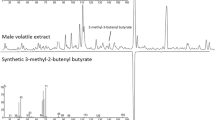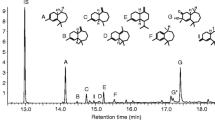Abstract
The egg parasitoid, Telenomus euproctidis Wilcox (Hymenoptera: Scelionidae), is phoretic on females of two allopatrically distributed tussock moths, Euproctis pseudoconspersa (Strand) and Euproctis taiwana (Shiraki) (Lepidoptera: Lymantriidae). Crossing experiments between the two regional parasitoid strains indicated no evidence for their reproductive isolation. More wasps were found on the locally occurring host, E. pseudoconspersa, than on E. taiwana, when virgin females of the two moth species were exposed concurrently in the field for 24 hr in Ibaraki Japan. In Ibaraki, many wasps were caught in traps baited with the synthetic sex pheromone of E. pseudoconspersa, 10,14-dimethylpentadecyl isobutyrate (10Me14Me-15:iBu), but none with that of E. taiwana, (Z)-16-methyl-9-heptadecenyl isobutyrate (16Me-Z9-17:iBu) or blank traps. In Okinawa, Japan, more wasps were found on E. taiwana than on E. pseudoconspersa, and many wasps were caught in traps baited with 16Me-Z9-17:iBu, but only a few with 10Me14Me-15:iBu, and none with blank traps. These results suggest that local wasp strains discriminate between the two sex pheromones, and they strongly prefer the sex pheromone of the moth occurring at their location.
Similar content being viewed by others
REFERENCES
ARAKAKI, N. 1990. Phoresy of Telenomus sp. (Scelionidae: Hymenoptera), an egg parasitoid of the tussock moth Euproctis taiwana. J. Ethol. 8:1–3.
ARAKAKI, N., WAKAMURA, S., and YASUDA, Y. 1995. Phoresy by Telenomus euproctidis (Hymenoptera): Scelionidae), an egg parasitoid on the tea tussock moth, Euproctis pseudoconspersa (Lepidoptera: Lymantriidae). Appl. Entomol. Zool. 30:602–603.
ARAKAKI, N., WAKAMURA, S., and YASUDA, Y. 1996. The phoretic egg parasitoid, Telenomus euproctidis (Hymenoptera: Scelionidae) uses sex pheromone of the tussock moth Euproctis tawiana (Lepidoptera: Lymantriidae) as a kairomone. J. Chem. Ecol. 22:1079–1085.
GODFRAY, H. C. J. 1994. Parasitoids: Behavioral and Evolutionary Ecology. Princeton University Press, Princeton, NJ.
INOUE, H., SUGI, S., KUROKO, H., MORIUCHI, S., and KAWABE, A. 1982. Moths of Japan. Kodansha, Tokyo (in Japanese).
LEWIS, W. J., and TAKASU, K. 1990. Use of learned odours by a parasitic wasp in accordance with host and food needs. Nature 348:635–636.
LEWIS, W. J., and TUMLINSON, J. H. 1988. Host detection by chemically mediated associative learning in parasitic wasp. Nature 331:257–259.
LEWIS, W. J., JONES, R. A., and REDLINGER, L. J. 1971. Moth odour: A method of host finding by Trichogramma evanescense. J. Econ. Entomol. 64:557–558.
LEWIS, W. J., JONES, R. L., NORDLUND, D. A., and SPARKS, A. N. 1975. Kairomones and their use for management of entomophagous insects: II. Evaluation for increasing rates of parasitization by Trichogramma spp. in the field. J. Chem. Ecol. 1:343–347.
NORDLUND, D. A., LEWIS, W. J., TODD, J. W., and CHALFANT, R. B. 1977. Kairomones and their use for management of entomophagous insects. VII. The involvement of various stimuli in the differential response of Trichogramma pretiosum Riley to two suitable hosts. J. Chem. Ecol. 3:513–518.
MINAMIKAWA, J. 1956. Biological notes on the Japanese brown tail moth (Euproctis pseudoconspersa Strand) (part 3). Stud. Tea 15:37–43 (in Japanese).
MIZUTA, K. 1981. An outbreak of Euproctis pseudoconspersa on Miyajima Islands. Bull. Hiroshima Agr. Coll. 6:429–440 (in Japanese).
TURLINGS, T. C. J., WACKERS, F. L., VET, L. E. M., LEWIS, W. J., and TUMLINSON, J. H. 1993. Learning of host-location cues by hymenopterous parasitoids, pp. 51–78, in A. C. Lewis and D. R. Papaj (eds.). Insect Learning: Ecological and Evolutionary Perspectives. Chapman and Hall, New York.
VET, L. E. M., and GROENEWOLD, A. W. 1990. Semiochemicals and learning in parasitoids. J. Chem. Ecol. 16:3119–3135.
VINSON, S. B., BARFIELD, C. S., and HENSON, R. D. 1977. Oviposition behaviour of Bracon mellitor, a parasitoid of the boll weevil (Anthonomus grandis). II. Associative learning. Physiol. Entomol. 2:157–164.
WAKAMURA, S., YASUDA, T., ICHIKAWA, A., FUKUMOTO, T., and MOCHIZUKI, F. 1994. Sex attractant pheromone of the tea tussock moth, Euproctis pseudoconspersa (Strand) (Lepidoptera: Lymantriidae): Identification and field attraction. Appl. Entomol. Zool. 29:403–411.
WILCOX, A. M. 1920. Notes and descriptions of species of Telenomus having ten-jointed antennae (Hymenoptera; Scelionidae). Psyche 27:78–81.
YASUDA, T., YOSHII, Y., and WAKAMURA, S. 1994. Identification of the sex attractant pheromone of the browntail moth, Euproctis similis (Fuessly) (Lepidoptera: Lymantriidae). Appl. Entomol. Zool. 19:21–30.
YASUDA, T., WAKAMURA, S., and ARAKAKI, N. 1995. Identification of the sex attractant pheromone components of the tussock moth, Euproctis taiwana (Shiraki) (Lepidoptera: Lymantriidae). J. Chem. Ecol. 21:1813–1822.
YASUMATSU, K., and WATANABE, C. 1965. A Tentative Catalogue of Insect Natural Enemies of Injurious Insects in Japan. Host Parasite-Predator Catalogue. Entomol. Lab., Fac. Agr., Kyushu University, Fukuoka.
Author information
Authors and Affiliations
Rights and permissions
About this article
Cite this article
Arakaki, N., Wakamura, S., Yasuda, T. et al. Two Regional Strains of a Phoretic Egg Parasitoid, Telenomus euproctidis (Hymenoptera: Scelionidae), That Use Different Sex Pheromones of Two Allopatric Tussock Moth Species as Kairomones. J Chem Ecol 23, 153–161 (1997). https://doi.org/10.1023/B:JOEC.0000006351.52413.f6
Issue Date:
DOI: https://doi.org/10.1023/B:JOEC.0000006351.52413.f6




